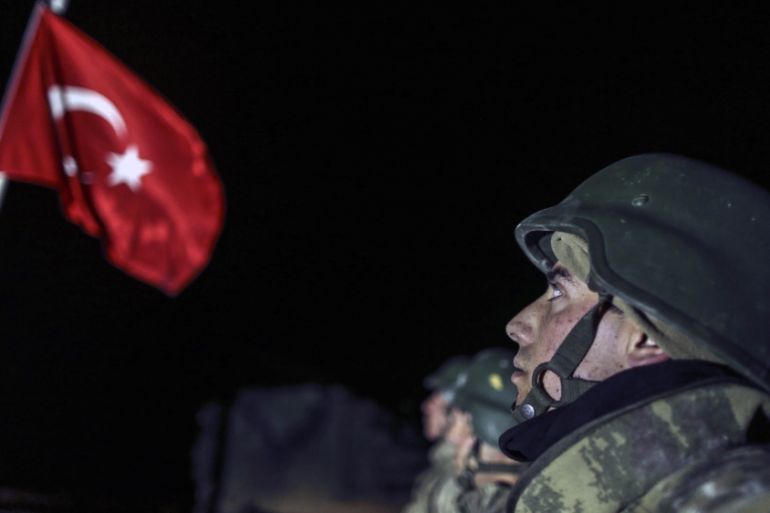Turkish troops pass smouldering Kobane to save shrine
Ottoman tomb too important for Erdogan to abandon but move signals no major policy change on ISIL.

Turkey’s decision to relocate the tomb of Tomb of Suleyman Shah – a piece of Turkish territory in Syria and the grandfather of Osman I, the founder of the Ottoman Empire – should come as no surprise, but it should not be interpreted as a change in Turkish policy on Syria. Instead, it should be seen as a marked continuation of Turkey’s policy of fence-sitting and reluctance when it comes to dealing with the threat ISIL poses to the region.
Relocating the tomb is in line with what to expect from Turkish President Recep Tayyip Erdogan. For a leader who sees Turkey’s role in the region through the lens of the Ottoman Empire, and for someone who sees himself as a neo-Ottoman sultan, the tomb is simply too important to abandon. The tomb has been under the control of Turkey for 700 years, and Erdogan does not want to be the one to go down in history as the leader who lost the tomb forever.
Keep reading
list of 4 itemsTurkish opposition wins major cities in local elections
What shapes Turkey’s municipal elections?
Turkey offers to host Russia-Ukraine peace talks as Erdogan hosts Zelenskyy
Slap in the face to Kobane
Turkey’s relocation of the tomb also shows Erdogan’s interesting priorities. For months, as the inhabitants of Kobane fought and died while besieged by ISIL, the Turkish military sat comfortably on the other side of the border. Turkey offered only limited assistance to the fighters and no military help was provided. Instead, the Turkish military served as mere spectators.
Does Turkey's evacuation and relocation of the tomb signal the possibility of a greater Turkish involvement in the fight against ISIL? Probably not. If anything it signifies a retreat of sorts - and acquiescence of Turkish sovereign territory to ISIL's control.
It was only after a 700-year-old tomb came under threat that Erdogan was willing to muster almost 600 soldiers, 57 armoured vehicles, and 39 tanks to take action. The fact that the journey from the Turkish border to the location of the tomb passes through Kobane only adds to this twisted irony. One can only guess what the Turkish soldiers were thinking as their convoy made its way through the still smouldering rubble and devastation of Kobane.
Does Turkey’s evacuation and relocation of the tomb signal the possibility of a greater Turkish involvement in the fight against ISIL? Probably not. If anything, it signifies a retreat of sorts – and acquiescence of Turkish sovereign territory to ISIL’s control.
Unless Turkey wanted to enter the fight against ISIL, and commit the necessary resources to defend the tomb, it had no choice but to remove the relics and sarcophagus to a safer location. Imagine the propaganda coup ISIL would have had if it captured the tomb and its defenders.
Across Iraq and Syria ISIL has a track record of destroying “idolatrous” tombs no matter their age, religion, or historical significance. The image of 40 Turkish soldiers in orange jumpsuits, locked away in cages while waiting to be burnt alive, would probably have forced Erdogan into doing something he does not want to do: enter the fight against ISIL.
Symbolism
For Erdogan the simple way to avoid this possibility was not by taking a more robust stance against ISIL but by removing the problem by removing the tomb. Considering that this operation took place without a shot being fired (although one Turkish soldier tragically died from an “accident”), one can only assume that there was coordination with the Kurdish fighters in the area – and probably with ISIL too.
Ankara said that there was coordination with the anti-ISIL coalition and this probably explains the increase in coalition air strikes in the area around the tomb in recent days.
The symbolism behind keeping the tomb outside Turkish borders and inside Syria should not be understated. For Erdogan, this is a matter of national pride. The Turkish authorities could have easily relocated the tomb inside Turkey, but this would not have fit with Erdogan’s neo-Ottoman image. There was no question that the tomb had to stay in Syria, even if it is now located in the small border village of Eshme – only a mere 200m from the border.
How Syrian President Bashar al-Assad will respond to the relocation of the tomb is anyone’s guess. He will not be happy, but he is in no position to do anything about it. The new location is well outside his control. There is no doubt that ISIL will try to attain some propaganda victory from the appearance of a Turkish retreat. Little if anything will change with Turkish policy resulting from the relocation. As Syria burns on its doorstep, Ankara will continue to hope that the conflict will not spill over.
Sadly, for the people of Turkey, “hope” is not a very good policy.
Luke Coffey is a research fellow specialising in transatlantic and Eurasian security at a Washington DC based think-tank. He previously served as a special adviser to the British defence secretary and was a commissioned officer in the United States army.
The views expressed in this article are the author’s own and do not necessarily reflect Al Jazeera’s editorial policy.
